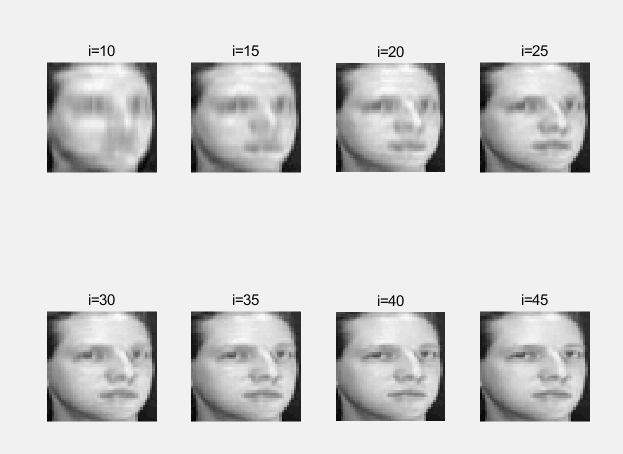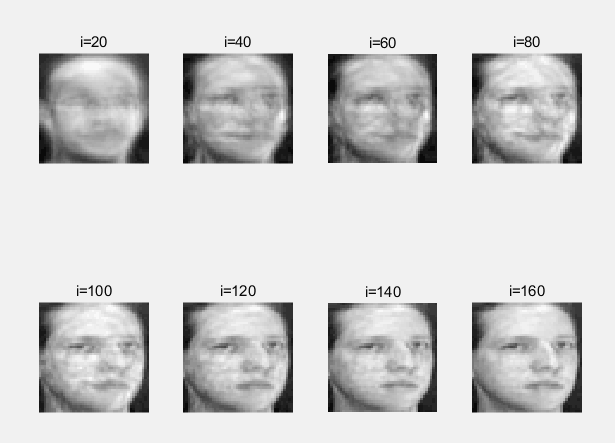1
2
3
4
5
6
7
8
9
10
11
12
13
14
15
16
17
18
19
20
21
22
23
24
25
26
27
28
29
30
31
32
33
34
35
36
37
38
39
40
41
42
43
44
45
46
47
48
49
50
51
52
53
54
55
56
57
58
59
60
61
62
63
64
65
66
67
68
69
70
71
72
73
74
75
76
77
78
79
80
81
82
83
84
85
86
87
88
89
90
91
92
93
94
95
96
97
98
99
100
101
102
103
104
105
106
107
108
109
110
111
112
113
114
115
116
117
118
119
120
121
122
123
124
125
126
127
128
129
130
131
132
133
134
135
136
137
138
139
140
141
142
143
144
145
146
147
148
149
150
151
152
153
154
155
156
157
158
159
160
161
162
163
164
165
166
167
168
169
170
171
| clear all;
load('ORL4646.mat');
test_data_index = [];
train_data_index = [];
for i=0:39
test_data_index = [test_data_index 10*i+1:10*i+4];
train_data_index = [train_data_index 10*i+5:10*(i+1)];
end
test_data = ORL4646(:, :, test_data_index);
train_data = ORL4646(:, :,train_data_index);
mean_face = mean(train_data, 3);
waitfor(show_face(mean_face));
cov_matrix = zeros(46, 46);
for i=1:size(train_data, 3)
centered_face = train_data(:,:,i) - mean_face;
cov_matrix = cov_matrix + centered_face' * centered_face;
end
scatter_matrix = cov_matrix / (size(train_data, 3) - 1);
[eigen_vectors, dianogol_matrix] = eig(scatter_matrix);
eigen_values = diag(dianogol_matrix);
[sorted_eigen_values, index] = sort(eigen_values, 'descend');
sorted_eigen_vectors = eigen_vectors(:, index);
single_face = train_data(:, :, 1) - mean_face;
index = 1;
X = [];
Y = [];
for i=10:5:46
project_matrix = sorted_eigen_vectors(:,1:i);
rebuild_faces = project_matrix * (project_matrix' * single_face) + mean_face;
subplot(2, 4, index);
index = index + 1;
fig = show_face(rebuild_faces);
title(sprintf("i=%d", i));
if (i == 45)
waitfor(fig);
end
projected_train_data = zeros(i,46,size(train_data, 3));
for j=1:size(train_data, 3)
projected_train_data(:,:,j) = project_matrix' * (train_data(:,:,j) - mean_face);
end
projected_test_data = zeros(i,46,size(test_data, 3));
for j=1:size(test_data, 3)
projected_test_data(:,:,j) = project_matrix' * (test_data(:,:,j) - mean_face);
end
k = 1;
minimun_k_values = zeros(k,1);
label_of_minimun_k_values = zeros(k,1);
test_face_number = size(projected_test_data, 3);
correct_predict_number = 0;
for each_test_face_index = 1:test_face_number
each_test_face = projected_test_data(:, :, each_test_face_index);
for each_train_face_index = 1:k
minimun_k_values(each_train_face_index,1) = norm(each_test_face - projected_train_data(:, :,each_train_face_index));
label_of_minimun_k_values(each_train_face_index,1) = floor((train_data_index(1,each_train_face_index) - 1) / 10) + 1;
end
[max_value, index_of_max_value] = max(minimun_k_values);
for each_train_face_index = k+1:size(projected_train_data, 3)
distance = norm(each_test_face - projected_train_data(:, :,each_train_face_index));
if (distance < max_value)
minimun_k_values(index_of_max_value,1) = distance;
label_of_minimun_k_values(index_of_max_value,1) = floor((train_data_index(1,each_train_face_index) - 1) / 10) + 1;
[max_value, index_of_max_value] = max(minimun_k_values);
end
end
predict_label = mode(label_of_minimun_k_values);
real_label = floor((test_data_index(1,each_test_face_index) - 1) / 10)+1;
if (predict_label == real_label)
correct_predict_number = correct_predict_number + 1;
else
end
end
correct_rate = correct_predict_number/test_face_number;
X = [X i];
Y = [Y correct_rate];
fprintf("i=%d,总测试样本:%d,正确数:%d,正确率:%1f\n", i,test_face_number,correct_predict_number,correct_rate);
end
plot(X,Y);
hold on;
function fig = show_face(vector)
fig = imshow(mat2gray(reshape(vector, [46, 46])));
end
function fig = show_faces(faces)
count = 1;
index_of_image_to_show = [1,5,10,15,20,25,30,35,40,100];
for i=index_of_image_to_show
subplot(2,5,count);
fig = show_face(faces(:, :, i));
title(sprintf("i=%d", i));
count = count + 1;
end
end
|


